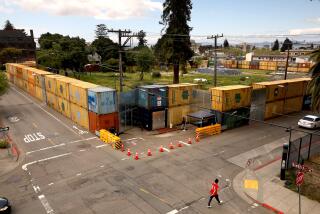AQMD Won’t Sue to Force Building of Ventura Freeway Diamond Lane
Saying that they had entered the fray too late, Southern California air quality regulators decided by a narrow margin Friday against suing to force construction of a “diamond lane,” restricted to car pools and buses, on the Ventura Freeway in the San Fernando Valley.
By a 5-4 vote, the South Coast Air Quality Management District board elected to forgo its threatened court action and to instead seek a stronger commitment from the Deukmejian Administration to car pool lanes on other freeways in the region.
However, two board members said after the vote that they expect one or more public-interest law firms to go to court in the district’s stead.
Clean Air Act Cited
Such a suit is expected to argue that the state Department of Transportation violated the federal Clean Air Act 14 months ago when it dropped plans to make the new eastbound fifth lane from Woodland Hills to Universal City a diamond lane.
In Southern California, Caltrans has three diamond lanes in operation, four more under construction and more than a dozen others under study.
But it backed away from placing such a lane on the Ventura Freeway when opponents swamped the highway agency with more than 12,000 protest letters, most of them from affluent West Valley and Ventura County residents.
Arguing that the source of most of the opposition is also the source of a good part of the region’s smog, AQMD board member Larry Berg argued that it was a “gross inequity” to build diamond lanes elsewhere in the region “but decide that affluent areas can send their crud east.”
The AQMD has long maintained that much of the smog in the eastern part of the Los Angeles Basin is generated in the western part.
Although West Valley diamond lane opponents took a drubbing from several other board members during the debate, the majority ultimately seemed to agree with member Henry W. Wedaa, a Yorba Linda City Councilman, who said it would be unwise to go to court because it was “very, very late in the suing process.”
Demand by AQMD
The AQMD, its powers newly expanded by the Legislature, unexpectedly entered the Ventura Freeway diamond lane controversy in November with a demand that Caltrans reverse itself and redesign the widening project, scheduled to begin early next year, to include a diamond lane.
Caltrans has sought to deter the air quality board, saying that the redesign would delay the much needed widening at least one year.
After several months of negotiation, John K. Geoghegan, an appointee of Gov. George Deukmejian who heads the state Business, Transportation and Housing Agency, which oversees Caltrans, said last week through a spokesman that “the issue is closed and it is time to move on.”
However, in a letter to the AQMD, Geoghegan held out the prospect of making the construction of a regional network of diamond lanes a part of the region’s air quality management plan, which would give the lanes legal status.
While the AQMD staff cited Geoghegan’s promise as a reason to drop the threatened lawsuit, Sabrina Schiller and several other board members dismissed it as “no commitment at all, just a vague promise to talk.”
Although cleaner air is the AQMD’s goal in pushing diamond lanes, highway planners in recent years have come to view them as essential for expanding freeway capacity at a time when funds for new freeways are scarce.
The most successful of the diamond lanes, the El Monte Busway, has induced large numbers of commuters to form car pools or ride buses, said Ron Klusza, a Caltrans diamond lane specialist.
He said the per-vehicle occupancy rate on the San Bernardino Freeway has climbed to 1.42, which he said is “significantly above the regional average of just under 1.2 people per vehicle.”
However, critics say the restricted lanes are unfair to those who travel at varying times and cannot car-pool, are unproved as a device for inducing motorists to form car pools or ride buses and increase accidents because diamond lane drivers must cross general-use lanes to get to and from the restricted lanes that are in the median.
For the 101 Freeway, Caltrans engineers calculated that a diamond lane and four general-use lanes would, after several years of use, carry 12,800 people an hour during peak commuting hours, while five general-use lanes would carry 12,000.
However, such projections failed to muster a strong endorsement for a diamond lane from a committee of business leaders, homeowner representatives and elected officials that studied the issue in 1986 and early 1987.
To the dismay of Caltrans’ planners, the committee voted 22 to 20 in favor of a car pool lane, with most business representatives in favor, most homeowner leaders opposed and elected officials split about evenly.
More to Read
Sign up for Essential California
The most important California stories and recommendations in your inbox every morning.
You may occasionally receive promotional content from the Los Angeles Times.










